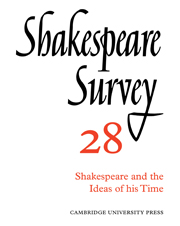Book contents
- Frontmatter
- ‘Richard II’ and the Realities of Power
- The Politics of Corruption in Shakespeare’s England
- Literature without Philosophy: ‘Antony and Cleopatra’
- Self-consciousness in Montaigne and Shakespeare
- ‘Measure for Measure’: The Bed-trick
- Shakespeare and the Doctrine of the Unity of Time
- ‘Coriolanus’ and the Body Politic
- ‘Titus Andronicus’, iii, i, 298–9
- ‘The Merchant of Venice’ and the Pattern of Romantic Comedy
- The Integrity of ‘Measure for Measure’
- ‘To Say One’: An Essay on ‘Hamlet’
- ‘The Tempest’ and King James’s ‘Daemonologie’
- Sight-lines in a Conjectural Reconstruction of an Elizabethan Playhouse
- The Smallest Season: The Royal Shakespeare Company at Stratford in 1974
- The Year's Contributions to Shakespearian Study 1 Critical Studies
- 2 Shakespeare’s Life, Times, and Stage
- 3 Textual Studies
- Index
- Plate section
Sight-lines in a Conjectural Reconstruction of an Elizabethan Playhouse
Published online by Cambridge University Press: 28 March 2007
- Frontmatter
- ‘Richard II’ and the Realities of Power
- The Politics of Corruption in Shakespeare’s England
- Literature without Philosophy: ‘Antony and Cleopatra’
- Self-consciousness in Montaigne and Shakespeare
- ‘Measure for Measure’: The Bed-trick
- Shakespeare and the Doctrine of the Unity of Time
- ‘Coriolanus’ and the Body Politic
- ‘Titus Andronicus’, iii, i, 298–9
- ‘The Merchant of Venice’ and the Pattern of Romantic Comedy
- The Integrity of ‘Measure for Measure’
- ‘To Say One’: An Essay on ‘Hamlet’
- ‘The Tempest’ and King James’s ‘Daemonologie’
- Sight-lines in a Conjectural Reconstruction of an Elizabethan Playhouse
- The Smallest Season: The Royal Shakespeare Company at Stratford in 1974
- The Year's Contributions to Shakespearian Study 1 Critical Studies
- 2 Shakespeare’s Life, Times, and Stage
- 3 Textual Studies
- Index
- Plate section
Summary
This article arises from work carried out on the construction of a model of an Elizabethan Playhouse, with some thoughts which have occurred to me subsequently. It is not suggested that the description which follows corresponds to any actual playhouse; rather an attempt is made to develop an ‘ideal’ Elizabethan stage, using such evidence, both direct and inferential, as we have. I hope, in so doing, to demonstrate that certain of the facts that are known can be made to fit into a structure much more rationally than has hitherto appeared.
Nevertheless, it should be stressed that this reconstruction deals in possibilities, not provable facts. Much of it is based on the use of sight-lines, and there is no evidence that Elizabethan theatre builders were much concerned with them. Hotson has said that the attention paid to sight-lines is of recent date. On the other hand, there is no evidence that any part of the audience could not see the stage: we are not precluded from making suggestions which would allow everyone to do so. By using the dimensions given or implied in various documents, and by placing them within the parameters set by the sight-lines, a structure can be developed which does fit together remarkably well. It is at any rate possible that some of the dimensions we have represent the result of a certain amount of trial and error, and were not arbitrary.
- Type
- Chapter
- Information
- Shakespeare Survey , pp. 125 - 136Publisher: Cambridge University PressPrint publication year: 1975

